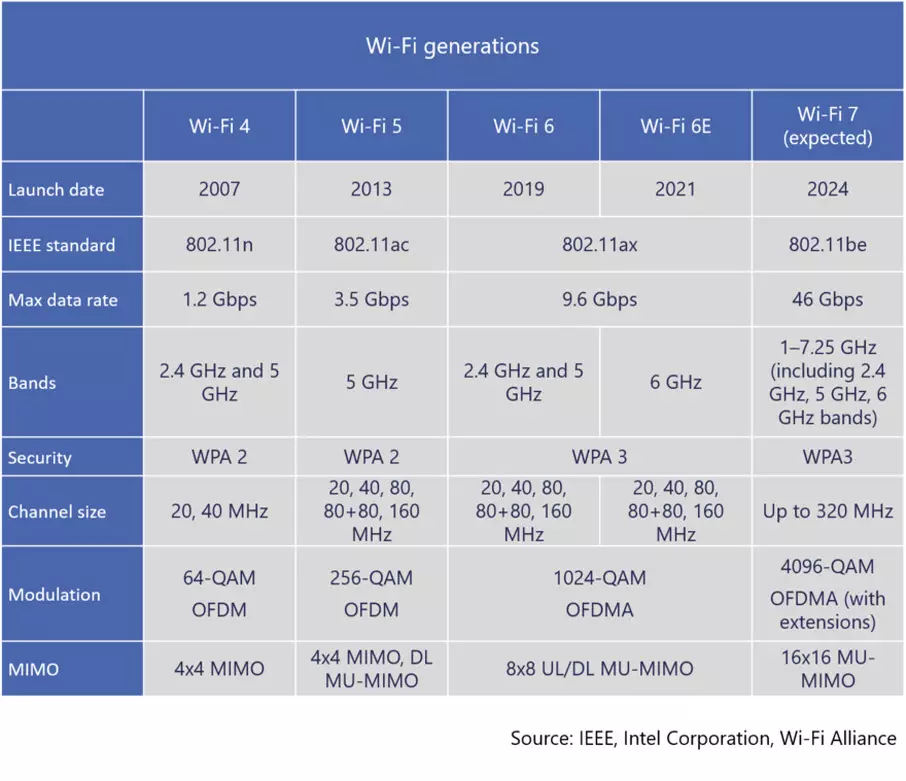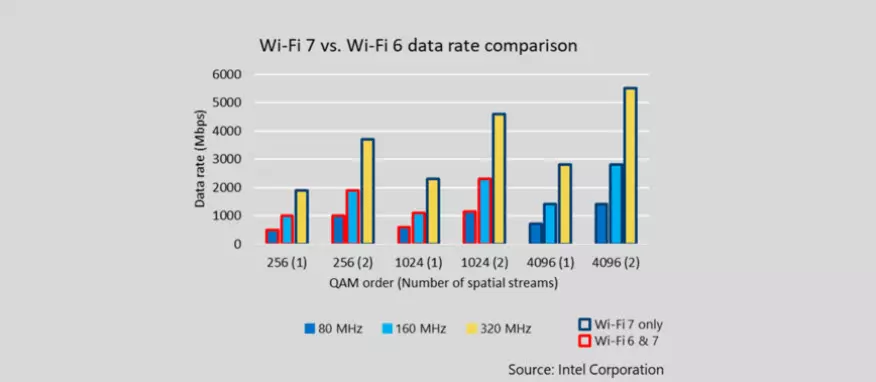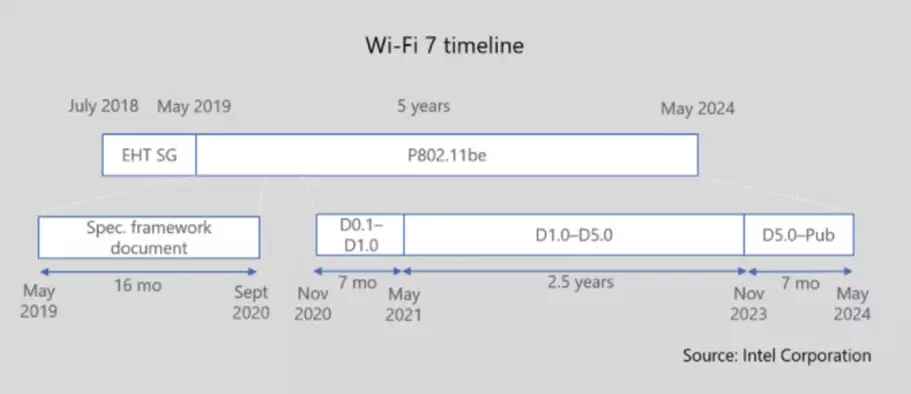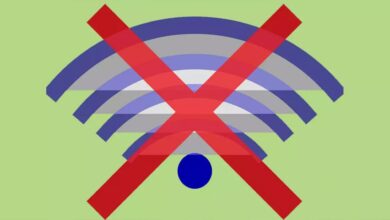
In the case of wireless networks, we have the 802.11 standard, which in different standards have been gaining speed and adding frequency bands to work. As for WiFi 7, it takes time to reach a consensus on standards that will be implemented by all manufacturers. In fact, it takes several years to develop and standardize a new standard until it is approved. Today’s protagonist is the WiFi 7 which corresponds to the 802.11be standard and which is being worked on since 2019.
What is expected of the new WiFi 7 standard
This 802.11be standard currently has a draft that describes the technical implementation necessary to meet the objectives that were set. Thus, in the field of companies, it is expected that it will benefit IoT and IIoT applications, also industrial automation, surveillance and remote control. Additionally, it could be used for future virtual reality, augmented reality, and other video-based applications that require high bandwidth, lowest possible latency, and highest connection reliability.
As for home users, we could also benefit from WiFi 7 in online gaming thanks to its lower latency. But that’s not all, we also have smart home services and also applications for virtual reality and augmented reality.
Regarding the expectations that we can expect from this new 802.11be standard, they are basically a higher real transfer rate and lower latency. We will also have greater spectrum efficiency and better energy efficiency, something that WiFi 6 already has thanks to OFDMA and TWT (Target Wake Time). Another aspect that we will also have is that we will have a better mitigation of interference thanks to the BSS Coloring that WiFi 6 already has, and we will be able to have many more devices connected simultaneously without the WiFi network becoming slow.
802.11be or WiFi 7 standard technologies
The EHT preamble and packet format in the universal signal field (U-SIG) it will provide us with forward compatibility for future changes in frame formats and transmission timing. In addition, it will facilitate the support for multiple PHY frame formats within the same wireless network.
In WiFi 7 we will have a maximum channel width up to 320 MHz. Thus, after doubling the maximum channel size with respect to Wi-Fi 6 (in the 5GHz and 6GHz band, the maximum channel width is 160MHz) we will be able to double the real performance of the connection. In this case, it allows 160 + 160 MHz channels, also 240 + 80 MHz and 160 + 80MHz channels to combine non-adjacent spectrum blocks. This means that it is not necessary for these to be contiguous, which will be useful to add channels with little use distributed throughout the frequency band, either 5GHz or the new 6GHz band that is available from the WiFi standard. 6E.
The 16 MU-MIMO antennas Compared to 8 that Wi-Fi 6 has at most, they can double performance in some scenarios. Also more antennas not only mean higher speed, but we will also have better penetration of the Wi-Fi signal. Thus, by having a signal with less noise in points close to the router, we could modular to 4096-QAM which translates into a significant increase in real speed. We must remember that the WiFi 6 standard allows up to 1024QAM in all frequency bands.
A Enhanced OFDMA With respect to the one introduced in the WiFi 6, it will increase the efficiency of the spectrum and reduce the latency. In this way, the experience and support of the most demanding users will be improved. This will be achieved by increasing the flexibility of OFDMAS by allowing the allocation of resource units to a single WiFi station. Multi-Access Point Coordination in which, thanks to the coordination between neighboring access points, it is possible to improve the use of resources, spectrum, reliability, performance and latency. Coordination can include OFDMA, SR, TDMA, BF, and joint processing.
With Multi-link operation MLO The devices can transmit and / or receive at the same time through different frequency bands and channels, with separation of data and control planes. In this way, thanks to the parallel links, the performance of the device is increased, its latency is reduced and it also improves its reliability. Also those data streams can be assigned to specific links depending on the program or device.
Maximum speed comparison between the WiFi 7 and WiFi 6 standard
Some may wonder if we need these speeds that Wi-Fi 7 is going to provide us. The answer is yes, since every time we demand greater bandwidth to watch our streaming content at a higher resolution, and we also have more devices connected to the wireless network. In addition, it is necessary to improve latency and for various activities such as gaming, which will be highly appreciated in order not to suffer LAG, in addition to video calls or VoIP calls.
In the following table you can see the evolution that the WiFi network has undergone from the WiFi 4 standard to the latest draft of WiFi 7, which is now officially available.
Thanks to Wi-Fi 6 we can get data speeds of 9.6 Gbps, as long as we use a router with 8 antennas and using a channel width of 160MHz channel width. Currently the maximum speed of the 5GHz band is 4.8Gbps because there is no WiFi router or access point that has more than 4 spatial streams.
On the other hand, with WiFi 7, the maximum data rate is 46 Gbps on a 320 MHz channel in 6 GHz and a 160 MHz channel in 5 GHz, with 4096-QAM and 16 spatial streams. The duplication of spatial flows and channel bandwidths result in a 4.8-fold increase in performance of WiFi 7 compared to Wi-Fi 6. On the other hand, the graph provided by Intel that you have below shows how it increases the data rate of Wi-Fi 7 thanks to a combination of wider channels, more QAM and more spatial streams.
In Wi-Fi 7, thanks to switching to 4096-QAM, the data speed has been improved, especially we will notice it in places close to the WiFi access point or router. However, the greatest performance of this future generation of Wi-Fi, which is already quite close, comes from doubling the channel size to 320MHz and increasing the number of spatial streams.
When will we see the new WiFi 7 standard?
The reality is that this new 802.11be standard that will introduce numerous improvements is closer than it seems. Here’s a timeline with the WiFi 7 forecasts:
It is expected that if everything follows the established plan, we could have the 802.11be standard approved by 2024. Then, not long after, the main manufacturers will launch their routers and other network equipment. Obviously, at the beginning like any novelty, they will be very expensive equipment but with the passage of time they will be more affordable for everyone. The same happened with Wi-Fi 6, and now we already have good quality equipment available in different price ranges.
In summary, WiFi 7 is going to bring us speeds of up to 46 Gbps theoretical, a channel size of up to 320 MHz and a lower latency that gamers will greatly appreciate.





